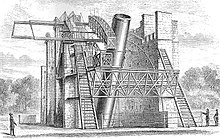Leviathan (telescope)
Leviathan (of Parsonstown) is the unofficial name for the reflecting telescope with which William Parsons, 3rd Earl of Rosse , recognized the spiral nature of galaxies . The name goes back to a huge sea monster in biblical mythology .
After William Parsons had successfully observed foggy objects with his 36-inch reflector telescope, he set up a reflector telescope with twice the diameter (183 cm, focal length approx. 16 m) from 1842. After three years of construction, it was put into operation in February 1845 at the Earl's Castle in Birr, Ireland . As early as April of the same year, Rosse recognized M51 that this object has a spiral structure. The famine in Ireland then prevented regular use of the giant telescope until 1848.
In principle it is mounted like a meridian telescope - between two parallel walls 15 m high - but it can be swiveled ten degrees to the east or west. So the wandering celestial objects can be followed for a while. The huge tube is brought into position by means of pulleys and winches . The telescope was not suitable for photographic recordings because it had no tracking mechanism . So it could only be used visually.
The observer stood at a height of up to 18 m above the ground on a bridge-like gallery.
The mirror of "speculum metal" ( speculum metal ), a bronze-like alloy, weighed only 3.8 tons. Its production required a special casting technique: if the block cooled too quickly, it could burst. After the failed first attempt, Lord Rosse had to provide more heating in order to allow the cooling to run slowly in a controlled manner.
Separate steam-powered machinery was constructed for grinding and polishing. The finished mirror was stored in its cell on 27 supporting points (later 81). The mirror surface tarnished relatively soon and thus reduced the amount of light that reached the observer. Therefore, the mirror had to be repolished every six months - a very laborious job, as the paraboloid shape also had to be restored. For this reason the telescope had two mirrors for quick exchange.
Despite the (inevitably) simple mechanics and the unfavorable weather conditions, the builder was able to make sensational observations. He was soon able to clearly determine in 14 galaxies that they had a spiral structure; He described 224 other as yet unknown nebulae for the first time.
Dreyer used the telescope from 1874 to 1878 . He was also able to discover a number of non-stellar objects and verify foreign observations. In doing so, he laid the basis for the New General Catalog (NGC), which was published in 1888.
Leviathan was by far the largest telescope in the world from 1845 and was not surpassed until 1917 with the commissioning of the 100-inch at Mount Wilson Observatory .
After the builder's son died in 1908, the telescope was dismantled and the mirror was taken to the Science Museum in London. Around 1914, the massive metal parts were melted down for war purposes, the tube and mechanics rot in the following decades.
However, the 6th Earl of Rosse took an interest in the device and collected written records about its design and operation. On the initiative of the amateur astronomer Patrick Moore , the restoration work began in March 1994 and was completed in 1999. The telescope is now equipped with a modern mirror (made of aluminum, not glass) and electronically controlled motors and - if the weather allows it - fully functional as it was 150 years ago.
Web links
swell
- ^ TR Robinson: On Lord Rosse's Telescope , Proceedings of the Royal Irish Academy, 1844
Coordinates: 53 ° 5 '48.1 " N , 7 ° 55' 2.6" W.

